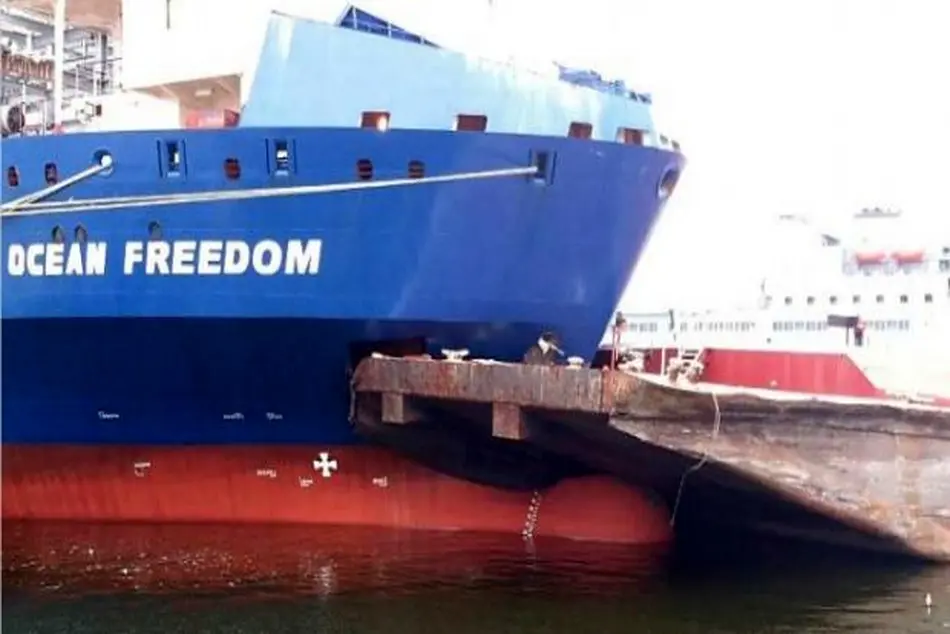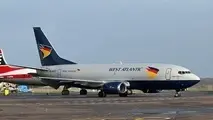NTSB: Cargo vessel allides with pier

TIN news: The National Transportation Safety Board (NTSB) issued an investigation report on the allision of the US-flagged cargo vessel “Ocean Freedom” with a tier of moored empty tank barges, while entering the Port of Corpus Christi, Texas, on October 2015.
The incident
The Ocean Freedom arrived at an offshore anchorage outside Aransas Pass, Texas, on October 24 from its last port of call in Rugao, China, with a cargo of about 200 tons of steel piping. Five days later, on October 29, the Ocean Freedom got under way about 1942 toward the entrance to Aransas Pass and picked up an Aransas-Corpus Christi pilot, as required. On the bridge was the master, who was in command; the officer of the watch (third mate); and a helmsman.
According to the master, the officer of the watch was responsible for complying with propulsion control orders from the pilot, confirming the pilot’s commands, and monitoring the vessel’s position. About 2028, the pilot met with the master on the bridge to conduct a master-pilot information exchange, which consisted of a brief dialogue about the working condition of the vessel’s equipment, the ship’s air draft for passage under the Corpus Christi Inner Harbor Bridge, the number of tugboats to be used, and the engine and bow thruster particulars. There was no detailed discussion about the inbound passage plan, however. When the pilot asked if the vessel was responsive, the master confirmed that it was and that it required only one tugboat for the current weather conditions. About 1 minute later, the pilot ordered full ahead and began directing the movement of the vessel into the channel entrance.
The pilot told investigators that as he commenced giving helm and propulsion orders to align the ship with the first set of range lights inbound he noticed that the ship was “a little bit to handle.” He said that he had to use “a lot of rudder” to bring the ship to the next course line while approaching the first large course change at the Harbor Island intersection. Once he had steadied up to the course line, he commented to the master that the turn was “terrible” and questioned the handling characteristics of the ship. The master assured him that the vessel “handles pretty good,” telling the pilot that the ship had adequate power with an effective bow thruster and that monitoring the stern provided a “good indicator” of the vessel’s movement and rate. The pilot said he then informed the master and bridge team members that ships like the Ocean Freedom (ships whose wheelhouses were located at the bow rather than at the stern) were “specialty ships” and were not handled often in the Port of Corpus Christi. He asked them to let him know if he was oversteering or if they saw anything out of the ordinary about his handling of the vessel.
At 2218, the Ocean Freedom passed under the Inner Harbor Bridge at half-ahead speed on a westerly heading into the turning basin. The pilot had an arrangement with an outbound grain ship, the YM Virtue, for a starboard-to-starboard meeting. With that passing arrangement, the Ocean Freedom was to favor the south side of the channel and the larger YM Virtue and its escort tug the north side. Moored on the south side of the channel was the ro-ro vessel United States Naval Ship (USNS) Benavidez.
With the vessel’s speed at about 6 knots, the pilot ordered full ahead at 2223, which was about the same time the Ocean Freedom passed the YM Virtue. Recognizing the Ocean Freedom’s position on the south side of the channel relative to the moored Benavidez, the pilot commented to the master, “I don’t like the look of this,” and went to the port bridge wing with the master to monitor their vessel’s proximity to the Benavidez. From the bridge wing they looked aft to view the 459 feet (140 meters) of ship behind them. At 2224, the pilot ordered in quick succession, “Right ten,” followed in seconds by “Right twenty,” and then “Hard right.” Both the third mate and the helmsman acknowledged the helm orders: the rudder was put to right. The pilot told investigators that his intention was to turn or “lift” the Ocean Freedom’s stern away from the Benavidez. Radar image from the voyage data recorder of the Ocean Freedom at 2224 with all vessels indicated in red, the Ocean Freedom and its heading in white, and the intended track line in blue.
At a speed of about 9 knots and a heading of about 267 degrees, the ship’s rate of turn began to increase to starboard as the vessel began to head in a northwesterly direction. The pilot, who was still on the bridge wing with the master looking aft, noticed that the stern of the Ocean Freedom was closing in on the Benavidez, which was not his desired effect. He contacted the Chloe K, the Ocean Freedom’s escort tugboat located aft of the vessel, to ensure they would clear the Benavidez; the skipper confirmed they would. According to an estimate by the master and the pilot, the Ocean Freedom’s stern cleared the Benavidez at an estimated distance of 100–150 feet.
Upon hearing that they cleared the Benavidez, the pilot and the master re-entered the bridge where, by this time, the ship’s rate of turn to starboard was high (about 64 degrees per minute) and the vessel’s heading was changing rapidly to the northwest in the direction of the north side of the channel. At 2225, the voyage data recorder (VDR) recorded a sequence of shouted orders of “Midships! Hard left! Full thruster to port!” followed by the movement of the propulsion to emergency astern. The master confirmed later that he communicated these orders and handled the propulsion lever.
As the Ocean Freedom moved across the approximately 800-foot-wide channel at about 9 knots directly toward a fleet of tank barges moored to the north bank, the pilot ordered the sounding of five short blasts on the ship’s whistle. Aware of the impending collision, he announced on VHF radio that there was an “emergency on the north bank” as the Ocean Freedom headed toward the barges. The crew on two tugboats tending the barges, the Nueces and the Pecos, having heard the whistle and radio calls, maneuvered clear of the Ocean Freedom. Just before 2226, the Ocean Freedom’s bow impacted the Kirby 28044, the outermost of the three moored tank barges, at about 8 knots on a heading of about 320 degrees. The barge’s starboard bow was lodged between the stem and the bulbous bow of the Ocean Freedom just above the waterline.
A crewmember from the Nueces was on board the Kirby 28044 conducting preloading checks when he heard both the Ocean Freedom’s whistle and the Nueces operator making a radio announcement to evacuate the barge. While trying to escape, the crewmember fell and injured himself. He suffered a broken left rib and knee injury, which required a brief hospital stay.
Following the collision, the pilot first made a mayday call for help from nearby vessels and harbor control. But with the Ocean Freedom blocking the channel and unable to maintain position within, the pilot then radioed harbor control requesting to moor at the open dock next to the Kirby barge fleet. Within minutes, there were multiple vessels on scene to help the vessel maneuver back to the dock where it was secured.
Probable Cause
The National Transportation Safety Board determines that the probable cause of the collision of the Ocean Freedom with the moored tank barges was the pilot’s rudder order in a direction opposite of which he intended. Contributing to the accident was the failure of the bridge team to identify the risk of collision and take appropriate action.
Further information may be found in the following report:



